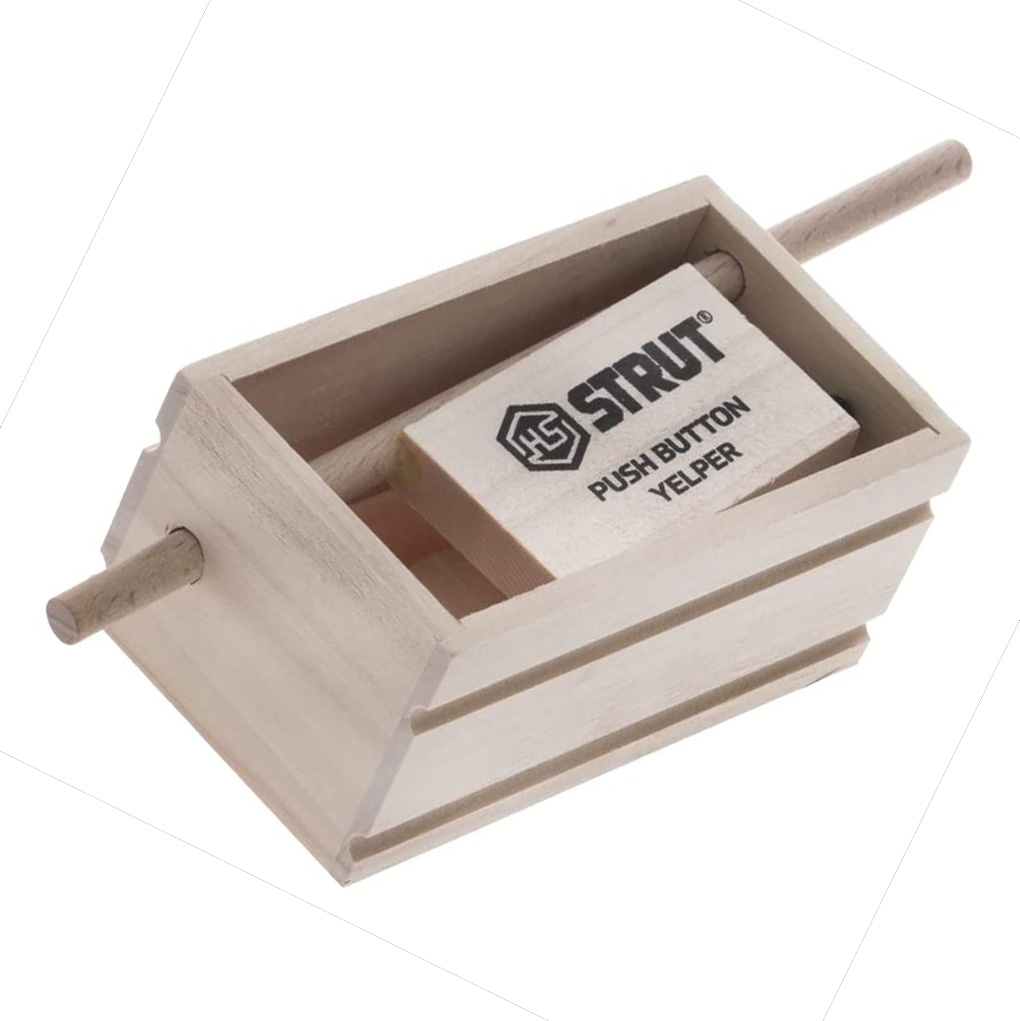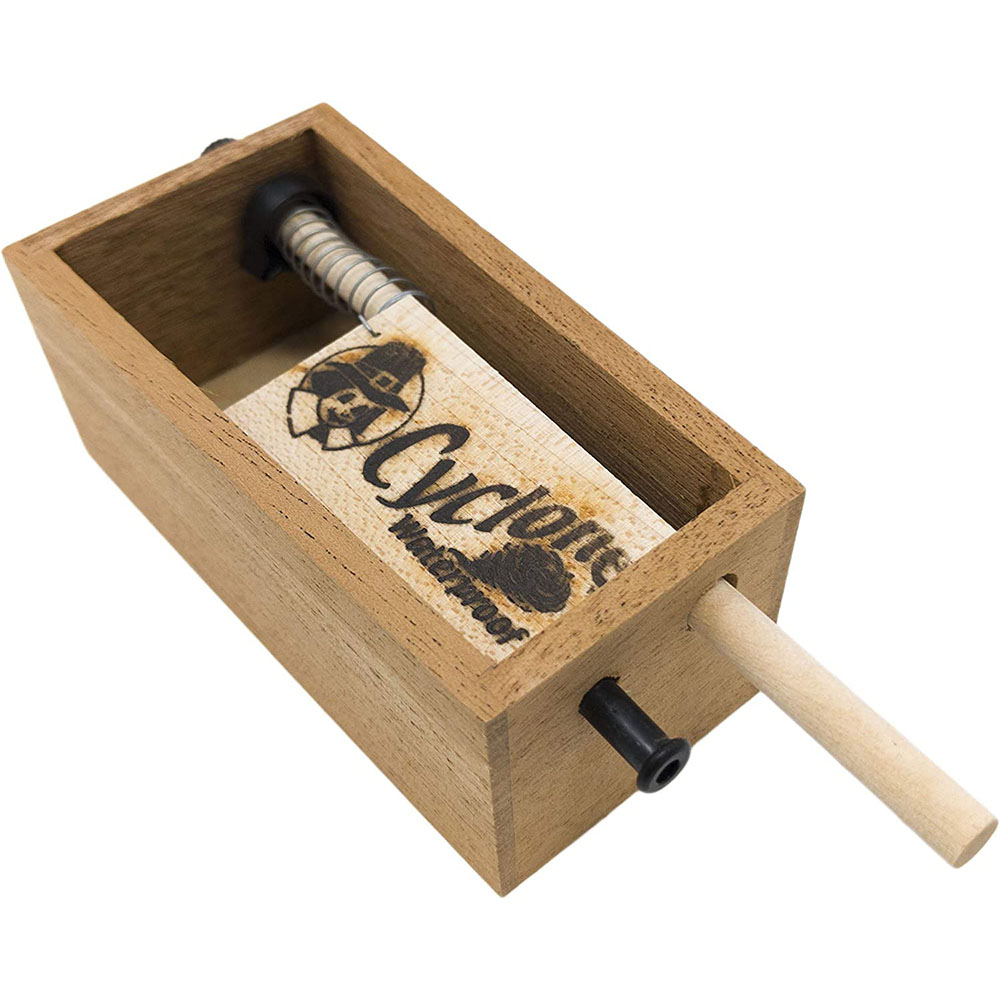For a new turkey hunter, choosing the right calls can be a daunting task. There are endless options in a variety of styles suited for a variety of skill levels. And while your turkey hunting vest may be able to hold dozens of calls, you really only need a few to get started.
In this article, we explore the best calls for beginner turkey hunters and provide a comprehensive guide to help you select the perfect call for your first or next hunt.
Before we dive into our eight top choices listed below, let’s first take a look at the four main types of turkey calls on the market, their pros, cons, and level of difficulty to learn.
Our Top Picks
- Best Friction Call: Woodhaven Cherry Classic Crystal
- Best Value Friction Call: H.S. Strut Cookie Cutt’r
- Best Budget Push-Pin Call: H.S. Strut Push Button Yelper
- Best Waterproof Push-Pin Call: Quaker Boy Cyclone
- Best Box Call – Primos Hook Up
- Best Waterproof Box Call – H.S. Strut Final Roost
- Best Beginner Mouth Call: Woodhaven Modified Cutter
- Best Selling Beginner Mouth Call: ESH React
Friction Calls

I start with friction calls because I believe they are the best call for a new turkey hunter. They are relatively easy to learn, and can accurately recreate all of the important sounds a hen turkey makes. The first few turkeys I killed met their demise as the result of cheap friction calls that I likely picked up at Walmart.
If you aren’t familiar with what a friction turkey call is, they typically consist of two pieces: a pot, or “soundboard”, and a striker. The pot is usually made of wood or plastic, with a calling surface on top. The calling surface may be made of slate, glass, aluminum, copper, or a variety of other materials.
The striker is a small wooden rod typically with some type of enlarged top or cap.
The wide range of materials used for making pots, calling surfaces, and strikers give each call its own unique sound.
How to Use
To use the friction turkey call, the hunter holds the pot in one hand and the striker in the other. By applying pressure and making circular motions with the striker against the calling surface of the pot, the hunter can produce a range of sounds that imitate various turkey vocalizations, including yelps, clucks, purrs and cackles.
The volume and tone of the call can be adjusted by changing the pressure and speed of the striker’s movements.
PROS
- Can produce a wide range of realistic turkey sounds
- Relatively easy to use
CONS
- May not work well in wet conditions
- Requires two hands to operate, so they are nearly impossible to use when a turkey is in sight.
- Heavier and bulkier than diaphragm calls
- Can be expensive depending on materials used
Push Pin Call
The push pin turkey call is the easiest call for a beginner to learn and use. In fact, they are pretty foolproof. The downside is they are limited in the sounds they can make, and aren’t as realistic as a friction or diaphragm call.
If you aren’t familiar with them, a push-pin call consists of a small wooden or plastic box with a wooden or plastic spring-loaded peg or “pin” protruding from the side.
While the push-pin call is simple and inexpensive, it can still be very effective at calling in a gobbler. If you’re brand new to turkey hunting, and don’t have the time or desire to learn to use a friction call right away, then the push-pin call is a good option to get you started.
How to Use
The hunter holds the box in the palm of one hand and uses his/her index finger to push the pin in and let the spring return the pin back to its original position. This back-and-forth movement produces a high-pitched, raspy noise that imitates the yelps and clucks of a hen turkey.
The volume and tone of the call can be adjusted by varying the pressure and duration of the pin’s movements.
PROS
- Extremely easy to use
- Affordable
- Can be operated with one hand
CONS
- Limited range of turkey sounds compared to other types of calls
- May produce unwanted noise if mishandled or used improperly
- Bulky compared to friction or diaphragm calls
Box Turkey Call

The box turkey call is a close second to the push-pin call in ease of use. There have been a lot of turkeys killed over the years by hunters with nothing more than a box call in their vest.
Box calls are a little more versatile than a push-pin call, but don’t offer the same range of sounds as friction and diaphragm calls. They are especially effective at calling loudly to locate a bird at a distance or on a windy day.
The box call consists of a small rectangular wooden box with a lid that slides back and forth across the top edges of the box, creating turkey sounds through friction.No matter what your skill level, a box call is a great tool to have in your turkey hunting tool box. The volume you can get from the call makes it great to elicit gobbles when nothing else is working. While it wouldn’t be my choice if I could only carry one call, it’s great to have one on-hand to compliment the other calls in your arsenal.
How to Use
To use the box turkey call, the hunter holds the box with one hand and uses the other hand to slide the lid back and forth. By varying the speed and pressure of the lid’s movements, the hunter can produce a range of turkey vocalizations, such as clucks, yelps, and gobbles. The volume and tone of the call can be adjusted by changing the speed and pressure of the lid’s movements.
PROS
- Easy to use, with some practice
- Creates a variety of turkey sounds
- Can create a lot of volume for calling to a distant bird or calling on a windy day
CONS
- Requires two hands to use
- May produce unwanted noise if mishandled or used improperly
- The bulkiest of all the calls discussed here
Diaphragm Mouth Calls

Diaphragm turkey calls, also known as mouth calls, are the most versatile of all the turkey calls, but they are also the most difficult to learn. With lots of practice, they can mimic just about any sound a hen turkey can make, and you can do it without having to use your hands.
Diaphragm calls consist of small latex reeds and a small, metal horseshoe-shaped frame covered in tape, that fits up in the roof of your mouth. By using your tongue to put pressure on the reeds and blowing air across them, the call can produce a wide range of turkey vocalizations.
Diaphragm calls come with various numbers of latex reeds with different styles of cuts in one or more of the reeds to produce different sounds. In general, calls with fewer reeds are easier to use and learn. Calls with more reeds can produce a raspier sound, but require more air to work.
The volume and tone of the call can be adjusted by changing the pressure and position of the tongue and the amount of air flow. Diaphragm turkey calls are versatile and allow hunters to produce a range of realistic turkey sounds with practice.
Because of the learning curve involved with using diaphragm turkey calls, I don’t recommend choosing one as the first turkey call you carry to the woods with you. I do, however, recommend going ahead and getting one so you can start learning how to use it.
How to Use
Get a quality double reed call like one of the two recommended below, watch a ton of instructional YouTube videos, and start practicing. You may not be ready to use it this season, but by next season, you should be able to make most of the sounds of a hen turkey and take your turkey hunting to the next level.
PROS
- The most versatile turkey call, producing all the sounds of a hen turkey
- Leaves your hands free to minimize movement
- Extremely compact and easy to carry
- Inexpensive
CONS
- Steepest learning curve of all the turkey calls
- Have to be properly stored and maintained to stay effective
Best Beginner Turkey Calls
Below we highlight our top picks for friction, push-pin, box, and diaphragm turkey calls. Keep in mind there are hundreds of call manufacturers producing thousands of turkey calls. Most all of them are capable of calling in a turkey on any given day.
My favorite may not end up being your favorite. Many times it’s a matter of personal preference, and which call you feel most confident with. But these are all solid options for a new turkey hunter just getting started.
Use these as a starting point, and as you build experience, take time to experiment with other types and brands of calls until you find the ones that give you the most confidence in the field.
Overall Best Friction Call
Woodhaven Cherry Classic Turkey Call
Woodhaven is well known among diehard turkey hunters for manufacturing quality calls. While they are on the expensive end of the turkey call price spectrum, their quality and sound is unmatched. If you’re looking for a great-sounding friction call and aren’t on a tight budget, then I’d highly recommend the Woodhaven Cherry Classic Crystal.
Key Features
- Produces a wide range of sounds
- Can be custom made with photos or laser engraved logos
- Surface conditioning kit, surface saver lid, and two hand-matched strikers
- Manufactured in the USA
Check current prices at:
Best Value Friction Call
H.S. Strut Cookie Cutt’r Pot Call
H.S. Strut has been producing turkey calls for as long as I can remember. They’re known for quality hunting products at affordable prices. What I love about the Cookie Cutt’r call for a beginner is the unique lid that helps guide new turkey hunters in how to move the striker on the call to make the various sounds of a hen turkey.
Key Features
- Injection molded pot coupled with a slate striking surface
- Cool lid to guide new turkey hunters on using the call
- Slate calling surface to accurately produce yelps, clucks and purrs.
Check current prices at:
Best Budget Push-Pin Call
H.S. Strut Push Button Yelper
H.S. Strut makes the list again with another affordable turkey call. This time it’s their Push Button Yelper. The hand-tuned, push-pin call is made of poplar and walnut, and does a great job of reproducing yelps, soft clucks and purrs. Being a push-pin call, the H.S. Strut Push Button Yelper is fool proof and a great option for the new turkey hunter on a budget.
Key Features
- Extremely easy to use
- Affordable
- Accurately replicates yelps, soft clucks, purrs, and tree talk
Check current prices at:
Best Waterproof Push-Pin Call
Quaker Boy Cyclone
Family owned Quaker Boy has been producing innovative turkey calls for over 45 years, and the Cyclone push-pin call is no exception. The call has mahogany sides, a maple striker, and birch dowel and is waterproof, so those rainy day turkey hunts are no problem. Additionally, the call requires no chalk and no sanding.
Key Features
- Mahogany, maple and birch construction
- Waterproof
- Adjustable volume
- Clucker button
- Requires no chalk or sanding
Check current prices at:
Overall Best Box Call
Primos Hook Up Magnetic Turkey Call
You couldn’t have a list of best turkey calls without an option from Primos. Primos has been around for four decades and has a reputation for making great hunting products for blue collar hunters. What I love about the Hook Up for new turkey hunters is the use of a strong magnet to keep the paddle at the perfect angle for realistic sounding yelps, cuts and purrs. The call also includes a Gobble Band for making great sounding gobbles as well.
Key Features
- Magnetic lid makes keeping the right lid angle and applying the proper pressure full proof
- Includes Gobble Band for realistic gobbles (be careful using that feature on public land!)
- Great sounding yelps, cuts and purrs at both loud and soft volumes
Check current prices at:
Best Waterproof Box Call
H.S. Strut Final Roost
The Final Roost box call features a walnut paddle on a poplar box for raspy yelps and cuts. The medium-sized box call features a waterproof paddle and box edge for those rainy or dewy mornings when many other calls just won’t perform. All these great features with an extremely affordable price tag.
Key Features
- Produces great raspy yelps, cuts and purrs
- Medium-sized call, so it doesn’t take up as much space in your turkey vest
- Waterproof lid and box edge for those rainy or dewy mornings
- Affordable
Check current price at:
Best Beginner Diaphragm Turkey Call
Woodhaven Modified Cutter
As I mentioned earlier, Woodhaven is know for making high quality custom turkey calls, and their mouth calls are some of the best on the market. Their Modified Cutter is a great option for beginners for its ease of use and ability to produce excellent yelps, cutts and cackles, as well as soft clucks, purrs, and tree yelps.
The call, designed by World Champion caller, Steve Stoltz, features a .004 top reed with a combo cut over two reeds of prophylactic, making it an easy call to blow for new turkey hunters and veterans alike.
Key Features
- Designed by World Champion caller Steve Stoltz
- Combo cut style makes it easy to blow for beginners
- Produces a wide range of sounds from aggressive cutts, yelps and cackles to soft clucks, purrs, and tree yelps.
Check current price at:
Best Selling Beginner Mouth Call
ESH React
A top seller on Amazon, ESH turkey calls are hand built by world champion turkey calls. The React is a 3-reed call with an inverted combo cut that is the perfect fool-proof mouth call for beginners. The call is designed to perfectly mimic soft clucks, purrs, yelps, and excited cutting.
Key Features
- Easy to blow and produces great clucks, purrs, yelps and cutting
- Designed by champion turkey caller Pat Strawser
- Hand built in the USA
Check current price at:
Calling Tips for Beginners
- Start with simple calls: Begin with the simplest calls, such as the basic yelp and cluck, before progressing to more complex calls. Focus on mastering these calls first, and then move on to others like the purrs, cuts, and cackles.
- Listen and imitate: Listen to the sounds of wild turkeys in their natural habitat and try to imitate them as closely as possible. Record your own calling and compare it to the sounds of wild turkeys to identify areas that need improvement.
- Practice regularly: Practice your calling regularly, preferably in the field or a similar environment. This will help you to develop a better understanding of the birds’ behavior and improve your calling skills.
- Use a variety of calls: Turkeys are vocal birds, so it’s important to use a variety of calls to mimic their natural sounds. A combination of soft and loud calls, as well as different pitches and tones, can make your calling more effective.
- Be patient and persistent: Wild turkeys can be elusive and unpredictable, so it’s important to remain patient and persistent when calling them. Don’t get discouraged if you don’t get a response right away. Keep practicing and experimenting with different calls until you find what works best for you in different situations.















